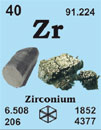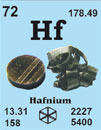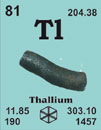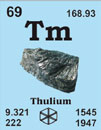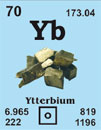Gadolinium 64Gd157.25
1880 von J.C. Galissard de Marignac in Genf, Schweiz, entdeckt. 1886 von P.E. Lecoq de Boisbaudren in Paris, Frankreich, rein dargestellt.
[Nach J. Gadolin, einem finnischen Chemiker, benannt]
French: gadolinium
English: gadolinium
Italian: gadolinio
Spanish: gadolinio
Beschreibung: Silberweißes Lanthanoidmetall. Reagiert langsam mit Sauerstoff und Wasser, löst sich in Säuren. Verwendet für Magnete, feuerfeste Steine, in der Elektronik, Neutronenradiographie und Magnetooptik.
Gadolinium single crystal properties
| State: |
Single crystal |
|---|
| Crystal structure: |
Hexagonal |
|---|
| Production method: |
Czochralski |
|---|
| Standard size: |
diameter 6-10mm
thickness 1-2mm |
|---|
| Orientation: |
(0001) |
|---|
| Orientation accuracy: |
<2°, <1°, <0.4° or <0.1° |
|---|
| Polishing: |
as cut, one or two sides polished |
|---|
| Roughness of surface: |
<0.03 µm |
|---|
| Purity: |
99.99% |
|---|
Further Materials properties
| Crystal structure: |
(cell dimensions/pm), space group,
a-Gd h.c.p. (a=363.60, c=578.26), P63/mmc
b-Gd b.c.c. (a=405), Im3m
T(a->b)=1535 K
High pressure form: (a=361, c=2603), R3m |
|---|
| X-ray diffractions mass absorption coefficients: |
CuKa 439 (µ/r) / cm2g-1
MoKa 64.4 (µ/r) / cm2g-1 |
|---|
| Neutron scattering length: |
0.65 b/10-12 cm |
|---|
| Thermal neutron capture cross-section: |
49000 sa / barns |
|---|
| Density: |
7.89 kg/m-3 [293 K]; 2390 [liquid at m.p.] |
|---|
| Melting point: |
1312.85 °C / 1586 °K |
|---|
| Boiling point: |
3265.85 °C / 3539 °K |
|---|
| Molar volume: |
10.00 cm3 |
|---|
| Thermal conductivity: |
10.6 [300 K] Wm-1K-1 |
|---|
| Coefficient of linear thermal expansion: |
8.6 x 10-6 K-1 |
|---|
| Electrical resistivity: |
134.0 x 10-8 [293 K] Wm |
|---|
| Mass magnetic susceptibility: |
+6.030 x 10-5(s) kg-1m3 |
|---|
| Young's modulus: |
54.8 GPa |
|---|
| Rigidity modulus: |
21.8 GPa |
|---|
| Bulk modulus: |
37.9 GPa |
|---|
| Poisson's ratio: |
0.259 GPa |
|---|
| Radi: |
Gd3+ 97; atomic 180; covalent 161 |
|---|
| Electronegativity: |
1.20 (Pauling); 1.11 (Allred); £3.3 eV (absolute) |
|---|
| Effective nuclear charge: |
2.85 (Slater); 8.22 (Clementi); 11.28 (Froese-Fischer) |
|---|
| Number of Isotopes (incl. nuclear isomers): |
23 |
|---|
| Isotope mass range: |
143 -> 163 |
|---|
Biological data
| Biological role: |
none, but acts to stimulate metabolism |
|---|
| Toxicity |
|
|---|
| Toxic intake: |
n.a. |
|---|
| Lethal intake: |
LD50 (chloride, oral, mouse)=>2000 mg kg-1 |
|---|
| Hazards: |
Gadolinium is mildly toxic by ingestion, but is a skin and eye irritant and a suspected tumorigen. |
|---|
| Level in humans |
|
|---|
| Blood: |
0.39 mg dm-3 |
|---|
| Organs: |
n.a., but very low |
|---|
| Daily dietary intake: |
n.a. |
|---|
Total mass of element in average
[70 kg] person: |
n.a., but very low |
|---|
Geological data
| Minerals: | Many minerals are known, and aluminium is present in many other minerals |
|---|
| Mineral | Formula | Density | Hardness | Crystal apperance |
|---|
| Bastnäsite |
(Ce, La etc.) Co3F |
4.9 |
4 - 4.5 |
hex., vit./greasy yellow |
| Monazite |
(Ce, La, Nd, Th etc.) PO4 |
5.20 |
5 - 5.5 |
mon., waxy/vit., yellow-brown |
| Chief ore: |
monazite, bastnäsite |
|---|
| World production: |
400 tonnes/year |
|---|
| Main mining areas: |
USA, Brazil, India, Sri Lanka, Australia, China |
|---|
| Reserves: |
c. 2 x 106 tonnes |
|---|
| Specimen: |
available as chips, foil or ingots. Safe. |
|---|
| Abundances |
|
|---|
| Sun: |
13.2 x 106 (relative to H = 1 x 1012) |
|---|
| Earth's crust: |
7.7 ppm |
|---|
| Seawater: |
|
|---|
| Atlantic surface: |
5.2 x 10-7 ppm |
|---|
| Atlantic deep: |
9.3 x 10-7 ppm |
|---|
| Pacific surface: |
6.0 x 10-7 ppm |
|---|
| Pacific deep: |
15 x 10-7 ppm |
|---|
| Residence time: |
300 years |
|---|
| Classification: |
recycled |
|---|
| Oxidation state: |
III |
|---|
Other sizes and specifications on request

 English
English
 Deutsch
Deutsch








































